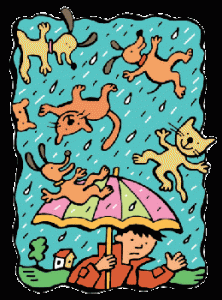
BACK TO SCHOOL
IS AROUND THE CORNER!!
As I’ve been saying all month, keep those ‘learning faucets’ flowing during the summer!
This is the final blog in a series of three based upon the webinar I conducted in June to help families. I offer many resources to help children with their literacy journeys. Feel free to go back and read my first two blogs on this topic.
I continue with the last strands of Scarborough’s Reading Rope having to do with Language Comprehension. As I mentioned, none of us are too old to continue developing in this arena–this type of learning continues throughout a reader’s lifespan!
I continue to suggest engaging activities you can easily do at home (yes, make the time!) to promote language comprehension. These additional resources correspond to the last part of the webinar (beginning at minute 47 and continuing to the end). Again, woven together with the Decoding (or Word Recognition) strands of the rope, it optimizes your children’s abilities to become proficient readers, which in turn, allows them to learn for a lifetime!
The remaining strands of the rope focus on Language Structure (what’s that, you ask??), Verbal Reasoning (and what’s that, you ask??), and Literacy Knowledge (and that??). I conclude with a Bonus Feature! I suspect you have difficulty keeping your kids away from screens, whether they are computers, tablets, or cellphones. Let’s use these tools to our advantage! I’ll share some positive ways you can use screen time to enhance literacy skills.
FOCUS ON LANGUAGE STRUCTURE
Human beings have the unique capability to learn oral language naturally through exposure and repetition. Our brains are ‘hard-wired’ to understand and speak without direct instruction. That’s pretty awesome if you think about it. Think about a baby or toddler you know and think about how their language skills change between birth and age 3. Did you know that most children know 1000 words by the time they are 3 years old?
The notion of Language Structure has to do with the word order or ‘rules’ of the native language.

The technical word for this is syntax. In other words, it is simply the way that words are ordered to form phrases and sentences that carry meaning. For example, children need to know that the correct English syntax would be “the red ball” vs. “the ball red”. Different languages have different syntactical rules.
For children who are bilingual (perhaps they speak Spanish in the home environment and then English in the school environment), it makes literacy development more complex since Spanish syntax differs from English syntax, even with this one phrase. Spanish syntax dictates that “the ball red” (‘la bola roja’) is indeed correct!
The educational system in America uses what is termed Standard American English (SAE). African American Children often use what is termed African American Vernacular English (AAVE) in their home environments. University of California-Irvine Professor and Speech Pathologist Julie Washington rightly notes that African American children must engage in ‘code-switching’, which adds an additional layer of complexity for children in their quest to develop literacy and that “dialect plays a role in the reading success of children — and how it may contribute to a gap in achievement and test scores. One way to narrow the gap is to help kids learn the dialect taught in schools and help schools accept the dialect students bring with them.” Code-switching involves differing syntax of AAVE and SAE.
Examples of how syntax affects literacy comprehension include:
1 – Subject-Object Confusion
For example, if you say your child or student, “Tim hid the cat in the shed”, and then ask, “Who is in the shed?” If the child responds with “Tim”, it indicates that the child has difficulty determining who (the subject) is doing what (hiding ‘the cat’–the object). This is just a simple example, as syntax gets far more complicated by the upper elementary grades.
2 – Pronoun Referents
Many children have difficulty with knowing what ‘he’, ‘she’, ‘it’, ‘they’ refer to in sentences. Referring to the sentence above about Tim and the hidden cat, if you then say to your child or student, “He went and got it after a while.” and then ask who ‘he’ refers to and ‘it’ refers to, some children will undoubtedly experience confusion. To solve these problems, it’s a good idea to practice various sentences and then draw a picture or act out the sentence to directly teach these skills (both subject-object confusion and pronoun referents) to your children. Different children will require varying amounts of practice, but it is surely doable.
3 – Transition Words/Phrases

Children need to have the ability to connect information within and between sentences. Making sure that our young ones understand words such as: because, since, first/next/last, but, for example, in conclusion, however, etc. will help. Many of these transition words or phrases (see below) are essential for children to know both for comprehension and writing, particularly paragraph and essay writing.
4 – Morphology
Morphology refers to the study of the ‘meaning’ parts of words, as the smallest unit of meaning is called a morpheme. Children need to know that ‘-s’ at the ends of words can mean plural (dog, dogs), present tense (jump, jumps), or even singular or plural possessive with the appropriate apostrophe placement (the dog’s leash or the dogs’ leashes). Children also need to know that ‘-ed’ most often signifies past tense (jump, jumped) and is sometimes pronounced as /ĕd/ (hunted), /t/ (jumped), or /d/ (yelled).

For older students, knowing meaningful parts of words such as prefixes or roots becomes increasingly important in terms of comprehension and written language skills. Examples of early prefixes kids should know are: pre- (before) and ex- (out). Examples of early roots kids should be aware of are: port (to carry), tract (to pull). Two resources I recommend are Morpheme Magic (more formal lessons) and Moose Materials (cards and games). Children love learning about how ‘words work’!
In general, for children who make syntax errors, model the sentence correcting the error, and then have your child repeat the sentence…then use the same syntax and words again and again. This is my best advice. It does take time and patience, but it is well worth it.
I find that children also enjoy the tried and true Mad Libs to practice syntax and language structure!
FOCUS ON VERBAL REASONING
Verbal Reasoning has to do with connecting what listeners/readers know about a topic to what they are hearing/learning about a topic. This involves the idea of ‘non-literal’ or ‘inferential’ comprehension of a text. It is different from asking a child to comprehend literal parts of a text such as ‘How many children were in the family?’ or ‘What color was the car?’ in favor of responding to something like this, straight from the Florida Center for Reading Research website, which provides many activities for kids grades K-3

Mom made a cake, decorated it, and put candles on it. There are
lots of balloons. Children came with presents. Everyone played games.
What is going on?
Answer: a birthday party!
Nowhere in the text does it directly tell the child that a birthday party is going on. It’s best not to show the picture. This picture is my add on!

In addition, kids of all ages enjoy learning about idioms such as “it’s raining cats and dogs”–and even their origins. Did you know that this idiom comes to us from medieval times prior to the provision of appropriate drainage on streets? When it rained heavily, cats and dogs often drowned in the streets! To learn more, I recommend Marvin Terban’s Scholastic Dictionary of Idioms.
Similes and metaphors can also stump literacy learners of all ages. Both involve the use of words to make comparisons and enhance imagery in the reader’s mind. A simile is a bit more straightforward and includes the prepositions: as, like, or since (“his personality was as cold as ice”). A metaphor is a bit more higher level and often attributes non-human qualities to humans (“he is a shining star”) or vice versa (“the falling snowflakes dance through the sky”).
Completing analogies is a good way for kids of all ages to improve their verbal reasoning skills. For example, ‘fingers’ are to ‘toes’ as ‘gloves’ are to ‘ _________’ (socks). Kids often miss this one, not realizing the relationship between the function of the glove to cover the fingers, completing this analogy with a response of ‘foot’ or ‘leg’. Practice some analogies from Learning Games for Kids–it’s a great way to pass time on a car ride!
FOCUS ON LITERACY KNOWLEDGE
This all begins in infancy, when we first begin to speak, sing, and read to children. Reading to young children fosters print awareness and conveys the idea that print has meaning. So yes, point to the words when you read aloud, even at very young ages since it ‘sets the stage’ for later literacy learning. As you can see below, my 12 month old granddaughter is quite aware of turning pages, although she is not yet at the point of knowing that a book proceeds from left to right and I have not yet seen her correct a book’s orientation.
Kids also need to be aware of the differences between narrative (fictional story with a structure involving setting, characters, problem, solution) and informational (non-fictional presentation involving main idea, details) text. Finally, as kids become older, they will learn about the different genres of books as displayed here:

In addition, kids of all ages enjoy learning about idioms such as “it’s raining cats and dogs”–and even their origins. Did you know that this idiom comes to us from medieval times prior to the provision of appropriate drainage on streets? When it rained heavily, cats and dogs often drowned in the streets! To learn more, I recommend Marvin Terban’s Scholastic Dictionary of Idioms.
FOCUS ON TECHNOLOGY: YOUR KIDS WANT TO USE IT

Although not a strand in The Reading Rope–remember, the Reading Rope is now 20 years old–technology now plays a big role in children’s literacy development whether we like it or not!!
Use technology yourself as an adult to help select good reading material for your children or students using Lexile’s Find a Book.
Take advantage of the many apps and websites pictured below to help you to help your kids and students. This way, you won’t be upset when you see your children looking at screens–who knows, maybe they are reading. You won’t be sorry!
SEVERAL STRATEGIES INCLUSIVE TO IMPLEMENT
…from Part 1:
#1 Make it FUN! Talk, sing, dance with your children as much as possible. Gamelike practice is preferred, especially when working on Phonological Awareness.
#2 Give your child(ren)/student(s) a choice when possible. Allow them to select books, even if they wish to read graphic novels or nonfiction. It’s all good.
#3 Set reading goals with your child(ren)/student(s)–number of minutes, number of pages/day, reading aloud together, etc. Take the lead!
#4 Make it a habit/routine and check-in with your child(ren)/student(s)
… from Part 2:
#5 Pick a theme and run with it!!
#6 Include Informational Texts/Podcasts, Graphic Novels, Children’s Series, Audio Books
#7 Try to use 3 NEW VOCABULARY WORDS per day and make a conscious effort to repeat them regularly. You will feel so good when you hear your child(ren)/student(s) beginning to USE these words in their oral language!
…new Part 3 Strategies:
#8 Practice Writing! Model and read what others write and writing practice will help your child develop improved language structures
#9 Think about Verbal Reasoning as teaching Problem Solving!
#10 Enjoy dialogic reading together!

BONUS STRATEGY
**Use Technology to your ADVANTAGE!**
“PARENTS (and how about GRANDPARENTS?) are in an optimal place to support and build upon these strands of the Reading Rope:
TALK, READ, and SHARE EXPERIENCES with your children as much as possible!”

Thank you Lorie for the Idiom dictionary suggestion. I always wondered about the origin of ‘It is raining cats and dogs.’ Great article….succinct and easy to understand for a novice parent…or teacher!
Dawn,
Glad you learned something new!! That is a feat in my book!! Share, share, share with your teachers and parents!
Lori
Thanks for your blog, nice to read. Do not stop.